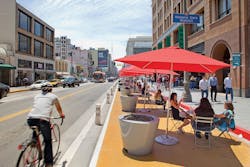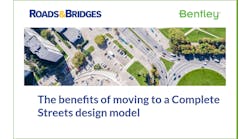By: Lauren Ballard, Lilly O’Brien, Jordan Fraade and Jess Jaworski
According to the National Highway Traffic Safety Administration, the year 2015 marked the end of a five-decade trend of declining traffic fatalities by showing a 7.2% increase over 2014.
This trend also was seen in the city of Los Angeles, which exhibited one of the highest collision death rates of any large city in the U.S. In Los Angeles, one person is killed in a traffic collision every two days—and 30% of these collisions involve people walking or bicycling, young people and/or the elderly. In fact, traffic collisions are the city’s leading cause of death for children ages 5-14 and the second greatest cause of death for people ages 15-25.
Enter Mayor Eric Garcetti, who issued an executive directive in August 2015, formally launching Vision Zero in Los Angeles.
LADOT’s collision data indicates a high number of pedestrians and cyclists, accounting for 15% of all collisions and 50% of traffic-related deaths.
Vision Zero is Los Angeles’ commitment to end all traffic deaths by the year 2025. It is a commitment to making the city a great place where people can travel safely and securely no matter what mode of transportation they choose. It makes human life the top priority in the design of city streets and identifies strategies for how government and members of the public can work together to reduce traffic deaths to zero with a specific focus on the most vulnerable road users.
The Vision Zero concept comes from Sweden, where it was adopted as a national strategy in 1997. Since then, Sweden has seen its number of transportation deaths drop by 30% despite a rise in traffic volume. According to the Vision Zero Network, New York, San Francisco, Seattle, Portland, Chicago, San Jose and San Diego also have adopted Vision Zero.
At its core, Vision Zero is a data-driven initiative. Upon making the Vision Zero commitment, the Los Angeles Department of Transportation (LADOT) undertook a rigorous data analysis to identify where traffic-safety efforts would produce the most significant results. In our collision data, we found that people walking and biking are overrepresented, accounting for 15% of all collisions but approximately 50% of all deaths on the road. Therefore, the city decided to focus on areas that have a higher concentration of these most vulnerable populations. These identified areas make up the High Injury Network (HIN)—386 corridors, or 6% of Los Angeles’ street miles, which account for 65% of all deaths and severe injuries involving people walking and biking. While all collisions cannot be prevented, LADOT can design and operate a road system that accounts for human error so that mistakes on the road do not lead to loss of life. The city is prioritizing strategic safety programs along these corridors.
Safety campaigns in L.A. are seeking to educate the public on street safety to reinforce safe driving, biking and walking habits.
Getting going
In January 2017, we launched our Vision Zero Action Plan, which will guide our path toward zero traffic deaths by 2025. In the Action Plan, we made a commitment to reduce traffic fatalities in Los Angeles by 20% by the end of this year. We know that we can do this by focusing engineering, enforcement, education and evaluation resources on 40 priority corridors (about 95 miles) of the HIN where we see the highest need for immediate intervention. Priority corridors were identified by their high concentration of fatal and severe injury collisions, especially those involving older adults and children, and in communities with poor health outcomes.
It all starts with engineering to create safe streets for all. This involves rethinking how the city’s streets and sidewalks are designed. Engineers are working on ways to anticipate human error and minimize the consequences of mistakes on the road. One way is by designing traffic-calming systems that reduce the chances of a death when a collision occurs. Right now, in an unprecedented coordinated effort, LADOT engineers are hard at work studying priority corridors and designing holistic interventions that will save lives. Their approach includes walking these corridors, paying particular attention to how the streets are used by the community, and flagging special land uses like schools, senior centers and grocery stores. Through a community outreach process, we will ground-truth our engineers’ plans to ensure they match the community’s experience of the corridor. We plan to install safety improvements on all 40 corridors by the end of this summer.
Vision Zero also requires educating the public about street safety for all road users, which is being accomplished through safety campaigns that reinforce safe driving, biking and walking habits. We are investing $2 million in a comprehensive education campaign that addresses top collision factors such as speeding and insobriety. Early this year, seven teams of community organizations were awarded up to $32,000 to develop a traffic-safety education campaign to promote road safety along one of the 40 corridors. As part of Vision Zero’s commitment to traffic safety education and equity, we believe traffic safety education should be developed in a language and style that reflects the personal experiences of each community. After all, who knows the history and culture of an area better than the people and organizations that live and work there? As begun this spring, our community partners will continue to help us throughout the summer to communicate Vision Zero’s core principles across Los Angeles’ many diverse communities using this localized approach. Alongside these community-based efforts, we launched a social-marketing campaign across physical and digital media spaces. The message is simple: “At 40 mph, even a good driver’s car is deadly. Check your speed to keep kids alive.”
Laws against dangerous driving behavior also must be enforced, which is why the Los Angeles Police Department will target DUIs, distracted driving, failure to yield in a crosswalk and other dangerous driving behaviors along the HIN. These enforcement plans also include an update of 100% of the expired speed surveys on the priority corridors by the end of 2017 and an update of all street-design standards to reflect a safe, multimodal city. To further develop a culture of safety, the city also plans to strengthen its relationships with key partners such as local trauma hospitals, community-based nonprofits, advocacy organizations, the Los Angeles County Department of Public Health and the American Automobile Association.
The last step in Los Angeles’ Vision Zero plan is evaluation, which is when the city takes a look at what has been done, what has worked, what has not worked, and assesses how we can improve on the results. LADOT is continuously evaluating its efforts to make sure that targets are being reached. It is through this evaluation that Vision Zero will continue to grow, change and innovate in the years to come.
The Safe Routes to School program in L.A. helps to ensure students safely walk from home to school and back.
Staying vigilant
Throughout the breadth of these processes, the city will strive to ensure that equity and engagement are central concerns. Currently, 49% of the HIN falls within the most vulnerable communities in Los Angeles, so Vision Zero has prioritized those interventions that will improve health conditions and outcomes in these areas of greatest need. The city also has engaged with a diverse group of organizations and individuals. The American Automobile Association has been a key member of the Vision Zero Task Force and Education Subcommittee. The city also hears from parents, teachers and principals about safety near schools through the Safe Routes to School program. Several other community-based organizations have united to form the Los Angeles Vision Zero Alliance, a coalition of diverse organizations and individuals working in partnership with the city of Los Angeles to realize Vision Zero.
Piloting the types of improvements that will soon come to our 40 priority corridors, Vision Zero has begun to improve traffic safety in Los Angeles. For example, in November 2015, a scramble crosswalk was installed at the congested intersection of Hollywood and Highland, home to the Chinese Theatre, Hollywood Walk of Fame and the Dolby Theatre, which hosts the Oscars every year. A pedestrian scramble stops traffic in all four directions when pedestrians are walking in the intersection. When the signal changes, vehicles can then make their movements without waiting for people to cross the street. Studies show that scramble crosswalks can lead to a 35% reduction in vehicular collisions with people walking. In the 11 months of 2015 before the scramble was installed, Hollywood and Highland had 19 collisions, 13 of which resulted in serious injuries. In the year and a half since the scramble was installed, there have been zero injury-causing collisions. It is intelligent, simple interventions such as this that can save lives.
2017 is a year of action for Vision Zero Los Angeles. We are motivated by our knowledge that serious injuries and deaths resulting from traffic collisions are preventable, and our belief that one traffic-related death is too many. We are propelled by our early successes and are ready to reduce traffic deaths by 20% this year. On the road to 2025, we will build safe streets for all, develop a culture of safety, enforce our laws that keep road users safe, and plan for a safer future for all Los Angeles residents.
---------------------
Ballard is with the Active Transportation Division of the Los Angeles Department of Transportation (LADOT). O’Brien is Deputy of Communications and External Affairs for Vision Zero at LADOT. Fraade is a Student Professional Worker at LADOT, working on policy and communications for the Vision Zero initiative. Jaworski is a Student Professional Worker at LADOT and, at the time this article was written, a Masters candidate at USC.






